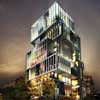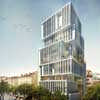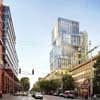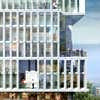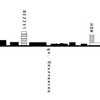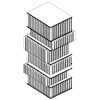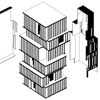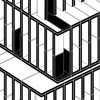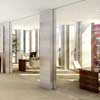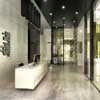Sofia Tower, Bulgaria, Architect, Project, Plans, News, Design, Property, Architecture, Picture
Sofia Tower Building, Bulgaria : Information + Images
Residential & Office Development by Aedes studio in Bulgaria
1 Feb 2010
Sofia Tower Building
Bulgaria – Exclusive to e-architect
2010-
Aedes studio
PRESENTATION OF THE BUILDING
Location
At A. Stamboliyski Blvd. and Shar Planina St., in the very centre of Sofia.
Floors
The building consists of:
– two-level basement with parking spaces equipped with mechanisms for double parking
– ground floor with shops and café
– 14 floors with offices
Structure
The structure of the building is monolithic, reinforced concrete. The structural solution follows the architectural shape which is unique and presents a challenge to the designers of the structure in many aspects.
Architecture
It is modern, differing, and impressive. The building has all prerequisites to become an emblematic repère for the city – not just a vertical of urban development but a characteristic mark which is both derived from the spot and permeating it with a new meaning.
Conveniences
A security installation, intercom installation, telephone installation, antenna installation for cable TV, structural cabling, fire alarm system, remote metering through individual metering devices with possibility for optimization of expenses – heat meter, water meter, power meter; lightning protection installation, grounding installation, central heating and air conditioning installation VRV type, and mechanic suction ventilation for the two levels of the underground parking.
ARCHITECTURAL CHARACTERISTICS
Architect Plamen Bratkov
The concept of the building has two points of departure: analysis of its location and analysis of its function.
In order to analyze the location we set off to it from Sveta Nedelia Square and along Al. Stamboliyski Blvd. We move in an urban environment typical for the centre of Sofia. The comparatively uniform outline of the buildings is interrupted once at Vazrajdane Square, and again – by the tall structure of the building of the National Social Security Institute. The new office building is at the same side of the street, and with its permitted height of 15 floors it has been determined to be the second vertical repère along that axis. That is why for its facing we chose light-colour stone similar to that used in the National Social Security Institute building.
After we cross Opalchenska Str. the environment is the following: On the right there is a long row of pseudo-classic Stalinist architecture buildings which starts from the very corner with the technical school. Our building is on namely on that “classic” side of the street. At the crossing on the right is the new and shining horizontal structure of the mall, the school after it, and some of the blocks of flats of the conventionally modern zone b5. In short, the environment here is non-homogenous in style, and on the other hand – as in many other sections of Sofia – development is yet to follow. This indefiniteness suggests some similarity with the office buildings of Chicago built in the first half of 20th century.
Thus we reach the second point of departure of our analysis: the fact that this is an office building. Its function together with the small area plot and considerable allowed height predetermine the vertical development. Since we intervene in urban tissue and create a new vertical repère, we limited our means of expression to a minimum set. At first those actually consisted in a classic set of distinguishable elements – slabs with colonnades between them. We refracted those elements through the prism of modernity, and they were turned into marks of assembling together of precast units resembling double T-panels. Colonnades were kept but joints cross the middle of each column and each slab, and they break up the structure which is monolithic at first glance, into components much smaller in size.
Had we lived in the first half of 20th century, we would have probably stopped here. The building would have been a smooth vertical structure with segmentation of the façade as described. But the world which we today live in is post-modern, with exactly so many versions of it as is the number of people inhabiting it. We refracted the form once again, this time submitting it to all possible attraction and repulsive forces with the respective directions into which they operate. Thus each “colonnade” was driven into its own way, all of them continuing to be parts of a whole.
When we move from the general concept to the concrete form a few other elements emerge which deserve attention. The “tower” or the main section of the building is constructed from two-floor and three-floor colonnades displaced in relation to each other. In plan they occupy one and the same perimeter; the difference is in their disposition. One of the floors is “intermediate” as a pause in the sequence. That floor lacks a colonnade and the structure is hidden behind the glass. Some “errors” – solid recesses instead of glass between columns – appear at several spots in the austere structure of volumes.
On both sides of the tower the building continues at the height of the neighbouring buildings. In both streets between the tower and the neighbouring buildings there are structures with openings in them, accomplishing and softening the transition. Those intermediate structures are in turn detached from the tower by a continuous glass joint which follows them in layout also along the vertical.
Part of the roof areas of the protruding and lateral structures are used as terraces and the remaining areas are used for roof planting.
The building has all prerequisites to become an emblematic repère for the city – not just a vertical of urban development but a characteristic mark which is both derived from the spot and in its turn permeating it with a new meaning.
Sofia Tower images / information from Aedes studio 010210
Location:Sofia, Bulgaria ‘
Bulgarian Architecture
Bulgarian Architecture
Bulgarian Building Designs – chronological list
Bulgarian Architect : Aedes studio – contact details
Sofia Buildings – Selection
Sofia City Centre Design
Dominique Perrault
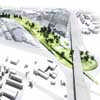
image © Perrault Projets Adagp
Sofia City Centre
Liulin Apartment Building
I/O architects
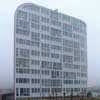
picture from architect
Sofia Apartment Building
Jaclyn Residential & Office Building
Aedes studio
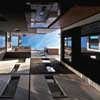
photo : Georgi Markov
Sofia Building
Bulgarian Resort Development by Foster + Partners
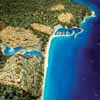
picture from architect
Comments / photos for the Sofia Tower Building Bulgaria Architecture page welcome
Sofia Tower Bulgaria
Architectural Walking Tours – city walks by e-architect
Website: Bulgaria

